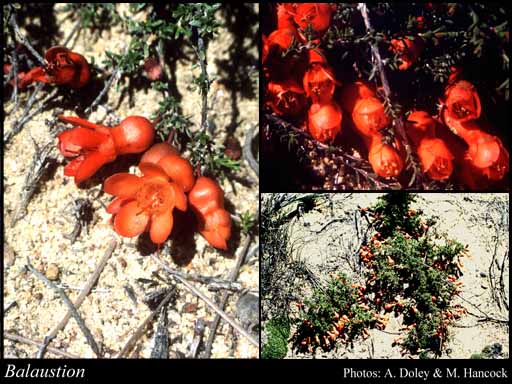- Reference
- Icon.Pl. 9:Tab.852 (1851)
- Name Status
- Current

Scientific Description
Common name. Native Pomegranates. Family Myrtaceae.
Habit and leaf form. Shrubs; evergreen; bearing essential oils. Plants with neither basal nor terminal concentrations of leaves; to 0.15–0.6 m high. Leptocaul. Helophytic to xerophytic. Leaves minute to small; opposite; ‘herbaceous’, or leathery; petiolate; gland-dotted; aromatic; edgewise to the stem, or with ‘normal’ orientation; simple; epulvinate. Leaf blades dorsiventral, or isobilateral, or centric; entire; flat, or solid; semi-terete, or solid/angular; linear, or lanceolate, or oblong, or ovate; linear, or orbicular; pinnately veined, or parallel-veined, or one-veined; cross-venulate, or without cross-venules. Mature leaf blades adaxially glabrous; abaxially glabrous. Leaves without stipules; without a persistent basal meristem. Leaf anatomy. Hairs absent. Stem anatomy. Secondary thickening developing from a conventional cambial ring.
Reproductive type, pollination. Fertile flowers hermaphrodite. Unisexual flowers absent. Plants hermaphrodite. Entomophilous, or ornithophilous. Pollination mechanism conspicuously specialized, or unspecialized.
Inflorescence and flower features. Flowers solitary; axillary; pedicellate; (bi) bracteolate; small to medium-sized; regular; 5 merous; cyclic. Free hypanthium present (petals ‘inserted on the calyx’); extending beyond ovary; adnate to the ovary at the base. Perianth with distinct calyx and corolla; 10; 2 -whorled; isomerous. Calyx present; 5; 1 -whorled; polysepalous, or gamosepalous (depending on interpretation); lobed; imbricate, or valvate; exceeded by the corolla; regular. Corolla present; 5; 1 -whorled; polypetalous; imbricate; regular; red, or pink. Androecial members indefinite in number. Androecium 30–40. Androecial members branched. Androecial sequence determinable, or not determinable. Androecial members maturing centripetally; free of the perianth; all equal; free of one another. Stamens 30–40; remaining included; polystemonous; erect in bud, or inflexed in bud. Anthers dorsifixed; versatile; dehiscing via longitudinal slits; introrse; cells parallel; tetrasporangiate; unappendaged. Gynoecium 3 carpelled. The pistil 3 celled. Gynoecium syncarpous; eu-syncarpous; inferior. Ovary plurilocular; 3 locular. Epigynous disk present. Gynoecium stylate. Styles 1; from a depression at the top of the ovary; apical; becoming exserted. Stigmas 1; capitate. Placentation axile. Ovules 5–10 per locule (i.e. ‘several’); ascending; in two rows on a peltate placenta; non-arillate; anatropous.
Fruit and seed features. Fruit non-fleshy; dehiscent; a capsule. Capsules loculicidal. Fruit 3 celled. Seeds non-endospermic. Cotyledons 2.
Geography, cytology, number of species. Native of Australia. Endemic to Australia. Australian states and territories: Western Australia. Eremaean Botanical Province and South-West Botanical Province.
Etymology. Name used by Dioscorides for the flowers of the wild pomegranate.
Keys
A Key to Western Australian Species in the Chamelaucieae Tribe of Myrtaceae
B.L. Rye, M.D. Barrett, T.D. Macfarlane, N.S. Lander, M.E. Trudgen, N.G. Marchant, K.R. Thiele